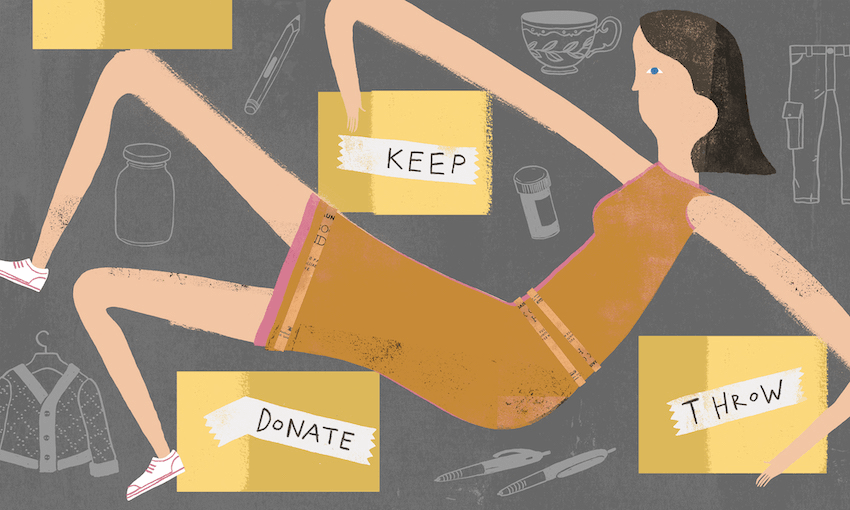James Borrowdale bids farewell to a summer of cricket with his oblivious baby daughter.
Made possible thanks to the support of Creative New Zealand
Original illustrations by Sophie Watson
If cricket, at least in its longer forms, can lay claim to something approaching artistic meaning – that is, for its actions to mean something outside of the game itself – some of that meaning is surely entwined in the game’s relationship to time. Time, and time’s constant shadow: change. The way the ball decays over an 80-plus-over life; the way a pitch erodes; the way a mind might over five days, over a series; the way an overburdened shoulder or knee can curtail a career. Time – its passing, its ravages – strikes me as the central fact of long-form cricket.
It was, as spring challenged winter’s tenancy in the sky and New Zealand’s domestic cricket season began, a concept much on my mind. My first child, a little girl, had been born a week into the first lockdown. “Today is a very sad day,” blared the front page of the New Zealand Herald on the morning of her arrival, quoting Jacinda Ardern. It was, somewhat auspiciously, the day of New Zealand’s first Covid death – a reminder of the direction in which time’s flashing neon arrow points us all. Time, and the limited amount of it that a single life allows, seems to me the fundamental concern of the minds that usher us through what we hope will be an 80-plus year life.
I had spent my partner’s pregnancy slogging away at my first book, which was experienced by her, at times, as a mental absence from anything outside its subject. Early on we decided that, book published, baby in the world, and my partner’s maternity leave expended, I would be the parent to stay home with the little one. Suddenly – for somehow it felt sudden – I found myself as a stay-at-home father with hours to fill between my daughter’s naps. Eden Park Outer Oval, the home ground of Auckland’s domestic teams, was to join the geography of the relationship between my daughter and me.
It was a slightly strange addition, as cricket grounds go. The playing oval is nestled in the shadow of Eden Park proper, the rear-facing ugliness of its western stand looming as a brutalist proscenium to the village-green proceedings below. Sandringham Road borders the other boundary, where a gentle embankment does little to hide the noise and traffic of Auckland bustling by.
By the time we first unfurled our rug on the grass between the old Merv Wallace Stand and the practice wickets, my daughter was five months old, sitting up and infinitely curious about the world outside our little home on the watery edges of West Auckland. Her schedule had formed fortuitously, allowing the 40-minute drive to the ground to account for the day’s first sleep and giving us most of the first session before unconsciousness came calling for her and our homeward journey, the car rumbling her into deep sleep, would commence.
And so, together we whiled away our time just beyond the boundary rope, she in the centre of a circumference of toys that demanded most of her attention, and me with one eye on the cricket. A flask of tea and a novel to dip into completed my happiness; a bottle of milk and her favourite toy wolf did the same for her. Around us were scattered fellow cricket cognoscenti – retired men for the most part, numbering a few dozen, who pointed deck chairs and, when spring’s climate allowed, hirsute bare chests at the action in the middle. My eyes would wander: book, cricket, baby.
One of those books – growing ever more dog-eared at the bottom of the baby bag – was Virginia Woolf’s The Waves. Time, also, is a central concern of that novel, but, elsewhere, it seemed almost to render my own summer, with its sense of hazy unreality caused by the accumulation of unsettled nights, on the page in front of me. “I lie back and regard the stiff-legged figures of the padded batsman through the trembling grasses… Faintly among the soft, white clouds I hear the cry ‘Run’, I hear the cry ‘How’s that?’ The clouds lose tufts of whiteness as the breeze dishevels them. If that blue could stay for ever; if that hole could remain for ever; if this moment could stay for ever—”
“Stay-at-home dad?” a voice asked from behind one morning, breaking a similar reverie. Auckland was in the field against Otago. Martin Guptill’s familiar shape was crouched at second slip; Kyle Jamieson’s towered at the top of his mark. Olly Pringle, a fast-bowler on debut, stood beyond the rope, patrolling the fine-leg boundary. That voice, as it turned out, belonged to his father, Martin, himself a former Auckland batsman. Over the periodic smack of leather on willow from practice pitches next door, he explained that he’d introduced the bowler in front of us, when he had been my daughter’s age, to the game in this exact fashion, at this exact ground – trundling the nascent cricketer home for a nap during the lunch break, and back for the afternoon session. My mind was fixated, for obvious reasons, on infancy, on beginnings. Pringle, at the outset of a first-class career, briefly became a beacon whose progress through the season seemed an omen.
But only briefly: summer flowered and successively shorter forms of cricket were pulled, like a deconstructing Russian doll, from the last. Pringle dropped out of the playing XI. My daughter grew, as did – with no job to make demands on my appearance – my beard. It was soon possible to watch batsmen in the throes of run-rate mania invert the commentators’ favourite expression by hoicking the ball into the stadium, or at least at it – the white ball pinging against Eden Park’s concrete derrière.
But the cricket highlights – a Jamieson hattrick featuring two of the booming in-swingers that would prove so effective in the international season to come, the electric batting form of William O’Donnell, the success of the Auckland women’s team – were mere accoutrements to the escalating achievements of this tiny child in life’s first bloom. Her teeth emerged, and then kept emerging, and with them came an escalating appetite for food whose preparation soon dominated my days, just as the Tupperware in which it was carted into town soon overwhelmed our cupboard space. She began crawling with a strange gait that dragged one of her shins, its skin soon noticeably coarsened, over the ground. That meant, of course, she was no longer fenced in by a collection of toys just beyond the boundary rope; no more could I dip into a novel as she sat idly beside me.
The men’s team faded quickly from T20 reckoning. The women fared much better, eventually finishing third. Then came the putting back together of the Russian doll, and the brief re-emergence of Covid that locked spectators out of the men’s final List A matches. Canterbury – the team of my youth, before a decade in Auckland and the birth of this little Aucklander had shifted my loyalty north – came to dominate, ticking off the titles. By now, the expanding interests of my daughter – playgroups, out-of-town family to visit – had come to disrupt our attendance, but it was, appropriately enough, Canterbury versus Auckland in the final of the Hallyburton Johnstone Shield, the women’s one-day competition, on the last day of cricket we watched together this summer.
Auckland batted first. A few friends joined us. Captain Lauren Down, whose form had done much to drag Auckland into the final, was out cheaply. Conversation, as wickets continued to regularly fall, turned to the immediate future: my daughter’s first birthday approached, there were job interviews to think about, a beard to shave off, a stalled career to re-establish, daycare to organise. The line into Eden Park that day was divided in two: one for the rugby game in the stadium, the other for the cricket below. Life, as I had recently known it, was ending. Time – measured in increments of cricket – had eaten up the first year of my daughter’s life. Time torn off, and used – to corrupt a phrase from Philip Larkin’s ‘Aubade’. And used well, in the shadow of Eden Park, in the light of a game that has given me so much pleasure. The innings ended, Auckland all out for 185. Unconsciousness called; the homeward journey commenced. Canterbury, unwatched by us, cantered to a resounding eight-wicket victory.
Summer, then, felt truly at its end. The Canterbury men, after the season’s customary soggy end, daylight savings italicising the sense of an ending, were confirmed as first-class champions – Canterbury, across the men’s and women’s competitions, had won four of a possible five titles. But more importantly, for me, stay-at-home fatherhood was almost at its end. Time, to return to Woolf, was about to give “the arrangement another shake”.




